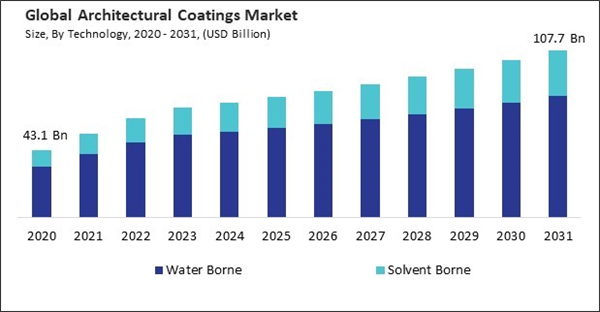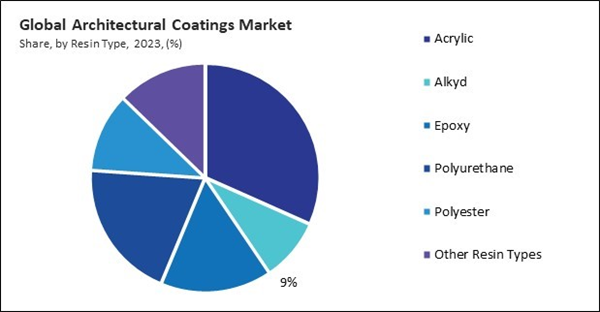The Global Architectural Coatings Market size is expected to reach USD107.7 billion by 2031, rising at a market growth of 5.5% CAGR during the forecast period. In the year 2023, the market attained a volume of 30,341.2 kilo tonnes experiencing a growth of 25.5% (2020-2023).
Urbanization and population growth in North America are leading to the construction of new residential complexes, commercial buildings, and infrastructure projects. The need for housing, office spaces, retail outlets, and public facilities is fueling North America's demand for these coatings. Consequently, the North American region would acquire nearly 28% of the total market share by 2031. Also, the US market would utilize 873.2 kilo tonnes of alkyd coatings this chemical by 2031.
Consumers increasingly seek customizable options for their residential and commercial spaces, driving demand for a wide range of colors, finishes, and textures in these coatings. Moreover, there is growing awareness of the impact of colors on mood and ambiance, leading to an increased focus on color psychology in architectural design. Therefore, the market is expanding significantly due to the growing focus on aesthetic appeal and design.
Additionally, Rising homeownership rates and changing consumer preferences drive demand for renovation and improvement projects. In addition, thermal insulation coatings lower heating and cooling expenses by increasing building energy efficiency. Thus, because of the increasing renovation and remodeling activities, the market is anticipated to increase significantly.
However, fluctuating raw material prices, including resins, pigments, solvents, and additives, lead to cost uncertainty and volatility for manufacturers. Moreover, uncertainty in raw material prices can hinder investment in research and development (R&D) and innovation. Therefore, supply chain disruptions are a significant challenge that hampers the growth of market.
Urbanization and population growth in North America are leading to the construction of new residential complexes, commercial buildings, and infrastructure projects. The need for housing, office spaces, retail outlets, and public facilities is fueling North America's demand for these coatings. Consequently, the North American region would acquire nearly 28% of the total market share by 2031. Also, the US market would utilize 873.2 kilo tonnes of alkyd coatings this chemical by 2031.
Consumers increasingly seek customizable options for their residential and commercial spaces, driving demand for a wide range of colors, finishes, and textures in these coatings. Moreover, there is growing awareness of the impact of colors on mood and ambiance, leading to an increased focus on color psychology in architectural design. Therefore, the market is expanding significantly due to the growing focus on aesthetic appeal and design.
Additionally, Rising homeownership rates and changing consumer preferences drive demand for renovation and improvement projects. In addition, thermal insulation coatings lower heating and cooling expenses by increasing building energy efficiency. Thus, because of the increasing renovation and remodeling activities, the market is anticipated to increase significantly.
However, fluctuating raw material prices, including resins, pigments, solvents, and additives, lead to cost uncertainty and volatility for manufacturers. Moreover, uncertainty in raw material prices can hinder investment in research and development (R&D) and innovation. Therefore, supply chain disruptions are a significant challenge that hampers the growth of market.
Driving and Restraining Factors
Drivers
- Growing focus on aesthetic appeal and design
- Increasing renovation and remodeling activities
- Rapid growth of construction activities
Restraints
- Fluctuating raw material prices
- Lack of supply chain disruptions
Opportunities
- Higher level of disposable income
- Technological advancements and product innovations
Challenges
- Limited availability of skilled labor
- Adverse impact of long replacement cycles
End-Use Outlook
By end-use, the market is bifurcated into residential and non-residential. The non-residential segment acquired 41% revenue share in the market in 2023. Industrial facilities, including factories, warehouses, manufacturing plants, and distribution centers, require durable and protective coatings for various surfaces.Resin Type Outlook
By resin type, the market is categorized into acrylic, alkyd, epoxy, polyurethane, polyester, and others. The polyurethane segment covered 20% revenue share in the market in 2023. In terms of volume, the segment registered 4,841.6 kilo tonnes in 2023. Polyurethane coatings provide excellent durability and long-term protection for various surfaces, including wood, metal, concrete, and plastic.Technology Outlook
On the basis of technology, the market is divided into solvent borne and water borne. The solvent borne segment covered 25% revenue share in the market in 2023. In terms of volume, the segment registered 6,514.9 kilo tonnes in 2023. Solvent-borne coatings offer exceptional durability and long-term protection for various surfaces, including wood, metal, concrete, and masonry.Function Outlook
Based on function, the market is classified into ceramics, inks, lacquers, paints, powder coatings, primers, sealers, stains, and varnishes. The paints segment garnered 17% revenue share in the market in 2023. Roof coatings protect and waterproof flat and sloped roofs made of various materials such as asphalt, concrete, metal, and tiles.Regional Outlook
Region-wise, the market is analysed across North America, Europe, Asia Pacific, and LAMEA. In 2023, the Asia Pacific region led the market by generating 39% revenue share. The Asia Pacific region is witnessing rapid urbanization and industrialization, leading to increased construction activities. Growing populations, rising incomes, and expanding urban areas drive the demand for residential, commercial, and industrial buildings in Asia Pacific.List of Key Companies Profiled
- PPG Industries, Inc.
- Wacker Chemie AG
- Nippon Paint Holdings Co., Ltd.
- The Sherwin-Williams Company
- BASF SE
- The Dow Chemical Company
- 3M Company
- Kansai Paint Co., Ltd.
- Akzo Nobel N.V.
- Arkema S.A.
Market Report Segmentation
By Technology (Volume, Kilo Tonnes, USD Billion, 2020-2031)
- Water Borne
- Solvent Borne
By End-Use (Volume, Kilo Tonnes, USD Billion, 2020-2031)
- Residential
- Non-Residential
By Resin Type (Volume, Kilo Tonnes, USD Billion, 2020-2031)
- Acrylic
- Alkyd
- Epoxy
- Polyurethane
- Polyester
- Other Resin Types
By Function (Volume, Kilo Tonnes, USD Billion, 2020-2031)
- Ceramics
- Inks
- Lacquers
- Paints
- Powder Coatings
- Primers
- Sealers
- Stains
- Varnishes
By Geography (Volume, Kilo Tonnes, USD Billion, 2020-2031)
- North America
- US
- Canada
- Mexico
- Rest of North America
- Europe
- Germany
- UK
- France
- Russia
- Spain
- Italy
- Rest of Europe
- Asia Pacific
- China
- Japan
- India
- South Korea
- Singapore
- Malaysia
- Rest of Asia Pacific
- LAMEA
- Brazil
- Argentina
- UAE
- Saudi Arabia
- South Africa
- Nigeria
- Rest of LAMEA
Table of Contents
Chapter 1. Market Scope & Methodology
Chapter 2. Market at a Glance
Chapter 3. Market Overview
Chapter 4. Global Architectural Coatings Market by Technology
Chapter 5. Global Architectural Coatings Market by End-Use
Chapter 6. Global Architectural Coatings Market by Resin Type
Chapter 7. Global Architectural Coatings Market by Function
Chapter 8. Global Architectural Coatings Market by Region
Chapter 9. Company Profiles
Companies Mentioned
Some of the key companies in the Architectural Coatings Market include:- PPG Industries, Inc.
- Wacker Chemie AG
- Nippon Paint Holdings Co., Ltd.
- The Sherwin-Williams Company
- BASF SE
- The Dow Chemical Company
- 3M Company
- Kansai Paint Co., Ltd.
- Akzo Nobel N.V.
- Arkema S.A.
Methodology

LOADING...










